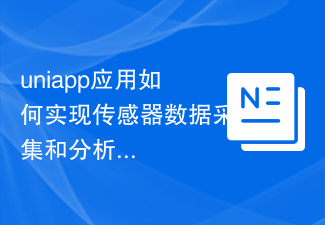
How to deal with data collection quality issues in C development
Abstract:
In C development, data collection is a critical and complex process. The quality of data collection directly affects the performance of the program and the accuracy of the results. This article will introduce several common data collection quality problems and provide corresponding solutions to help developers improve data collection quality.
Introduction:
In the C development process, data collection is a very important link. Whether reading data from external devices or collecting data through sensors, it is necessary to ensure that the collected data can truly reflect the actual situation. However, due to various reasons, quality problems often occur during the data collection process. This article will propose solutions to these problems to help developers improve the quality of data collection.
1. Data loss
During the data collection process, data may be lost due to hardware failure, communication problems or other reasons. In order to solve this problem, the following measures can be taken:
- Use buffer: Introduce a buffer during the collection process, store the collected data in the buffer first, and then process it later. In this way, even if data loss occurs, the data can be retrieved in the buffer.
- Exception handling: During the collection process, capture and handle possible exceptions, such as abnormal access to hardware or communication errors. Handling these exceptions promptly can avoid data loss.
2. Poor data quality
During the data collection process, some outliers or noise may appear. In order to improve data quality, the following measures can be taken:
- Filtering: Filter the collected data to remove outliers and noise. Commonly used filtering methods include mean filtering, median filtering, Gaussian filtering, etc.
- Calibration: Calibrate the collection equipment to ensure that its output data meets a certain accuracy and reliability. For example, when a sensor collects data, it can be calibrated by comparing it with known true values.
- Data verification: Verify the data during the collection process to ensure that the collected data meets expectations. Verification can be done by setting thresholds or performing statistical analysis on the data.
3. Data synchronization issue
In some scenarios, data collected by multiple devices needs to be synchronized. In order to solve the data synchronization problem, the following measures can be taken:
- Time stamp: While collecting data, record the timestamp of data collection. During subsequent processing, data collected by multiple devices can be synchronized through timestamps.
- Clock synchronization: Ensure that the clocks of multiple devices are synchronized. The clock accuracy of the device can be ensured through Network Time Protocol (NTP) or other clock synchronization methods.
Conclusion:
C development, data collection quality is a key issue. This article provides solutions to data loss, poor data quality, and data synchronization problems to help developers improve the quality of data collection. By taking these steps, you can improve the performance of your program and the accuracy of your results, ensuring that your data truly reflects reality.
The above is the detailed content of How to deal with data collection quality issues in C++ development. For more information, please follow other related articles on the PHP Chinese website!
 如何处理C++开发中的数组越界问题Aug 21, 2023 pm 10:04 PM
如何处理C++开发中的数组越界问题Aug 21, 2023 pm 10:04 PM如何处理C++开发中的数组越界问题在C++开发中,数组越界是一个常见的错误,它能导致程序崩溃、数据损坏甚至安全漏洞。因此,正确处理数组越界问题是保证程序质量的重要一环。本文将介绍一些常见的处理方法和建议,帮助开发者避免数组越界问题。首先,了解数组越界问题的原因是关键。数组越界指的是访问数组时超出了其定义范围的索引。这通常发生在以下场景中:访问数组时使用了负数
 如何解决C++开发中的文件权限问题Aug 21, 2023 pm 09:03 PM
如何解决C++开发中的文件权限问题Aug 21, 2023 pm 09:03 PM如何解决C++开发中的文件权限问题在C++开发过程中,文件权限问题是一个常见的挑战。在许多情况下,我们需要以不同的权限访问和操作文件,例如读取、写入、执行和删除文件。本文将介绍一些解决C++开发中文件权限问题的方法。一、了解文件权限在解决文件权限问题之前,我们首先需要了解文件权限的基本概念。文件权限指的是文件的拥有者、拥有组和其他用户对文件的访问权限。在Li
 PHP学习笔记:网络爬虫与数据采集Oct 08, 2023 pm 12:04 PM
PHP学习笔记:网络爬虫与数据采集Oct 08, 2023 pm 12:04 PMPHP学习笔记:网络爬虫与数据采集引言:网络爬虫是一种自动从互联网上抓取数据的工具,它可以模拟人的行为,浏览网页并收集所需的数据。PHP作为一种流行的服务器端脚本语言,在网络爬虫和数据采集领域也发挥了重要的作用。本文将介绍如何使用PHP编写网络爬虫,并提供实际的代码示例。一、网络爬虫的基本原理网络爬虫的基本原理是通过发送HTTP请求,接收并解析服务器响应的H
 如何处理C++开发中的图像清晰化问题Aug 21, 2023 pm 08:57 PM
如何处理C++开发中的图像清晰化问题Aug 21, 2023 pm 08:57 PM如何处理C++开发中的图像清晰化问题摘要:清晰化图像是计算机视觉和图像处理领域一个重要的任务。本文将讨论如何使用C++来处理图像清晰化问题。首先介绍图像清晰化的基本概念,然后探讨几种常用的清晰化算法,并给出使用C++实现这些算法的示例代码。最后,给出一些优化和改进的建议,以提高图像清晰化的效果。引言图像清晰化是图像处理领域的一项重要任务,它旨在提高图像的视
 如何解决C++开发中的内存越界问题Aug 21, 2023 pm 09:45 PM
如何解决C++开发中的内存越界问题Aug 21, 2023 pm 09:45 PM如何解决C++开发中的内存越界问题在C++开发中,内存越界问题是一项常见但又令人头痛的难题。内存越界指的是程序访问了超出其分配内存空间范围的区域,这会导致程序崩溃、数据破坏或者安全漏洞等问题。下面将介绍一些常见的解决内存越界问题的方法。使用动态内存分配:在C++中,使用new操作符进行动态内存分配可以帮助我们控制内存的分配和释放。通过分配足够的内存空间,并严
 如何解决C++开发中的环境配置问题Aug 21, 2023 pm 08:49 PM
如何解决C++开发中的环境配置问题Aug 21, 2023 pm 08:49 PM如何解决C++开发中的环境配置问题C++是一种广泛应用于系统软件、游戏开发等领域的高级程序设计语言。在进行C++开发时,正确配置开发环境是十分重要的。然而,由于C++的复杂性和不同的操作系统平台,环境配置问题常常困扰着开发者。在本文中,将介绍一些解决C++开发中环境配置问题的方法。首先,在开始进行C++开发之前,首先要确定开发所需的IDE(集成开发环境)。目
 cheerio和puppeteer之间的区别是什么?Aug 25, 2023 pm 07:45 PM
cheerio和puppeteer之间的区别是什么?Aug 25, 2023 pm 07:45 PMCheerio和Puppeteer是两个流行的JavaScript库,用于网页抓取和计算机化,但它们具有独特的功能和使用案例。Cheerio是一个轻量级库,用于解析和操作HTML和XML文件,而Puppeteer是一个更强大的库,用于控制无头Chrome或Chromium浏览器以及自动化Web浏览任务。Cheerio用于网页抓取和信息提取,而Puppeteer用于网页计算机化、测试和抓取。Cheerio和Puppeteer之间的选择取决于您的特定需求和必需品。Cheerio是什么?Cheerio
 uniapp应用如何实现传感器数据采集和分析Oct 25, 2023 am 11:49 AM
uniapp应用如何实现传感器数据采集和分析Oct 25, 2023 am 11:49 AMUniApp是一种跨平台的应用开发框架,它支持在同一份代码中同时开发iOS、Android、H5等多个平台的应用。在UniApp中实现传感器数据采集和分析的过程可以分为以下几个步骤:引入相关插件或库UniApp通过插件或库的形式扩展功能。对于传感器数据采集和分析,可以引入cordova-plugin-advanced-http插件来实现数据采集,同时使用ec


Hot AI Tools

Undresser.AI Undress
AI-powered app for creating realistic nude photos

AI Clothes Remover
Online AI tool for removing clothes from photos.

Undress AI Tool
Undress images for free

Clothoff.io
AI clothes remover

AI Hentai Generator
Generate AI Hentai for free.

Hot Article

Hot Tools

Zend Studio 13.0.1
Powerful PHP integrated development environment

mPDF
mPDF is a PHP library that can generate PDF files from UTF-8 encoded HTML. The original author, Ian Back, wrote mPDF to output PDF files "on the fly" from his website and handle different languages. It is slower than original scripts like HTML2FPDF and produces larger files when using Unicode fonts, but supports CSS styles etc. and has a lot of enhancements. Supports almost all languages, including RTL (Arabic and Hebrew) and CJK (Chinese, Japanese and Korean). Supports nested block-level elements (such as P, DIV),

Notepad++7.3.1
Easy-to-use and free code editor

ZendStudio 13.5.1 Mac
Powerful PHP integrated development environment

VSCode Windows 64-bit Download
A free and powerful IDE editor launched by Microsoft






